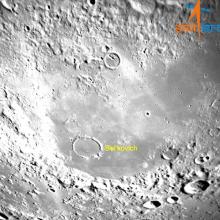Listen to today's episode of StarDate on the web the same day it airs in high-quality streaming audio without any extra ads or announcements. Choose a $8 one-month pass, or listen every day for a year for just $30.
You are here
Moon and Companions
The crescent Moon has a couple of colorful companions the next couple of mornings: the planet Mars and the star Antares. Both have a distinctly orange hue. Mars’s color is caused by reddish dust on its surface. Antares is colored by the temperature of the gas that makes up its surface.
There’s a bit of orange on the Moon as well — the residue of volcanic eruptions. The crew of the final Apollo mission found a patch of orange soil, which contained many orange glass beads. Scientists have seen similar beads mixed in with the soil from other locations. A few of the beads even contain water — suggesting there’s a lot of water mixed in with the lunar dirt.
Such color is a rarity on the Moon, though. Most of the surface is dark grey. It consists of plains of volcanic rock and jumbled highlands, all topped by the sticky, powdery dirt.
Neither pictures nor descriptions by astronauts depict much of any other color. Perhaps the most colorful bits of the Moon, in fact, are those that came from Earth. The Apollo landers were coated in gold foil. And astronauts set up American flags at all six of their landing sites. But exposure to unfiltered sunlight could have washed away much of that color — leaving the Moon as colorless as when astronauts arrived there.
Look for the Moon and its companions before sunrise. Mars is below the Moon tomorrow, with brighter Antares farther to the lower right. Both will be to the upper right of the Moon on Tuesday.
Script by Damond Benningfield






